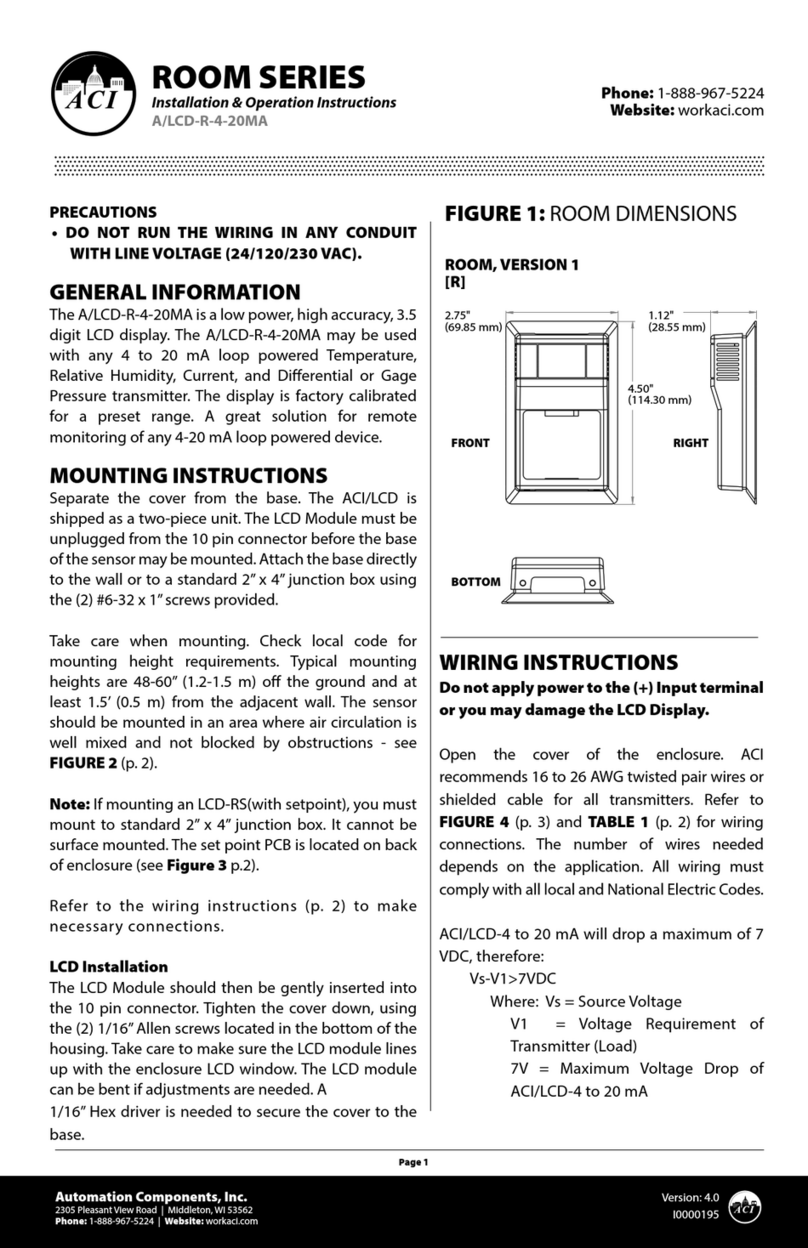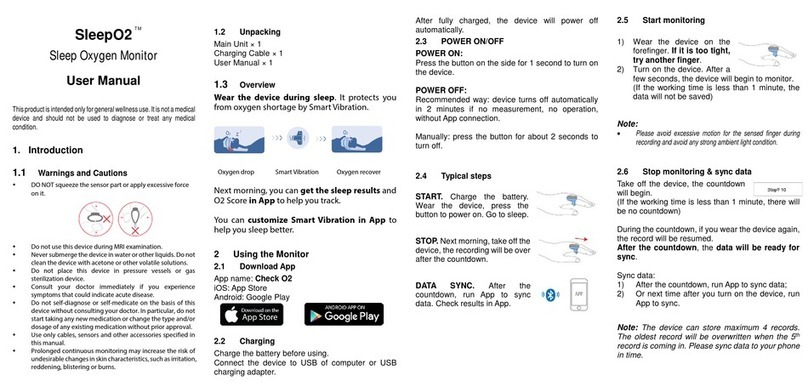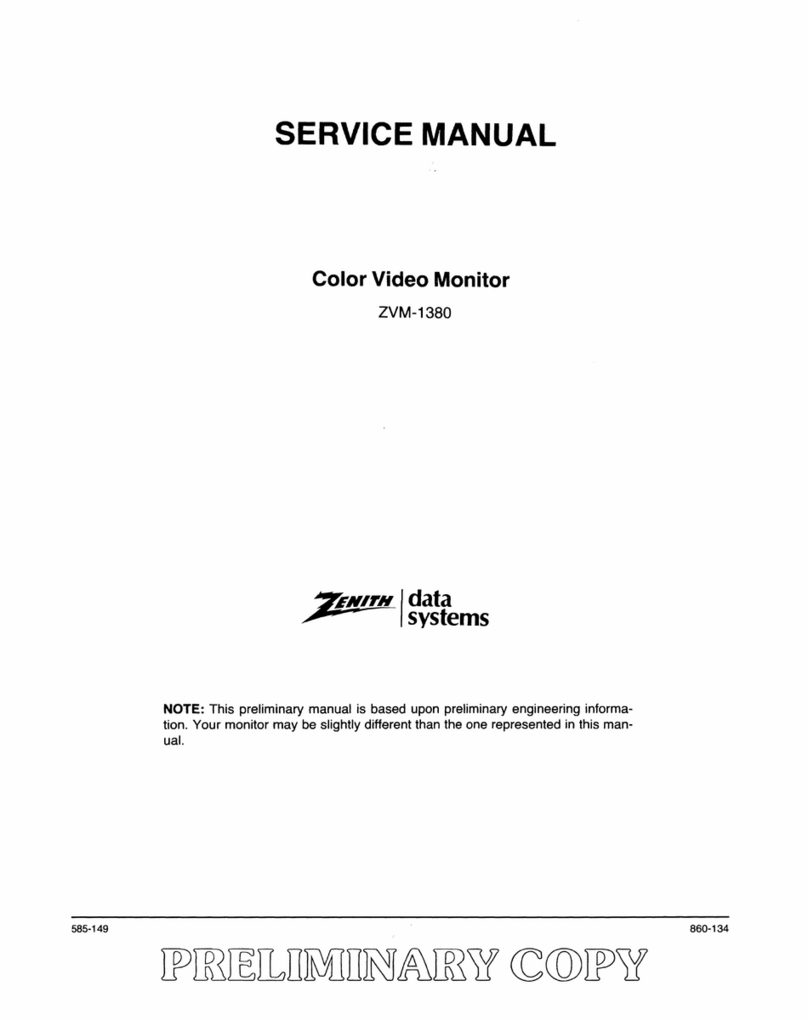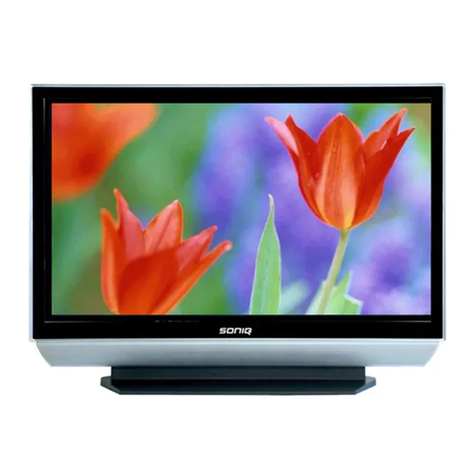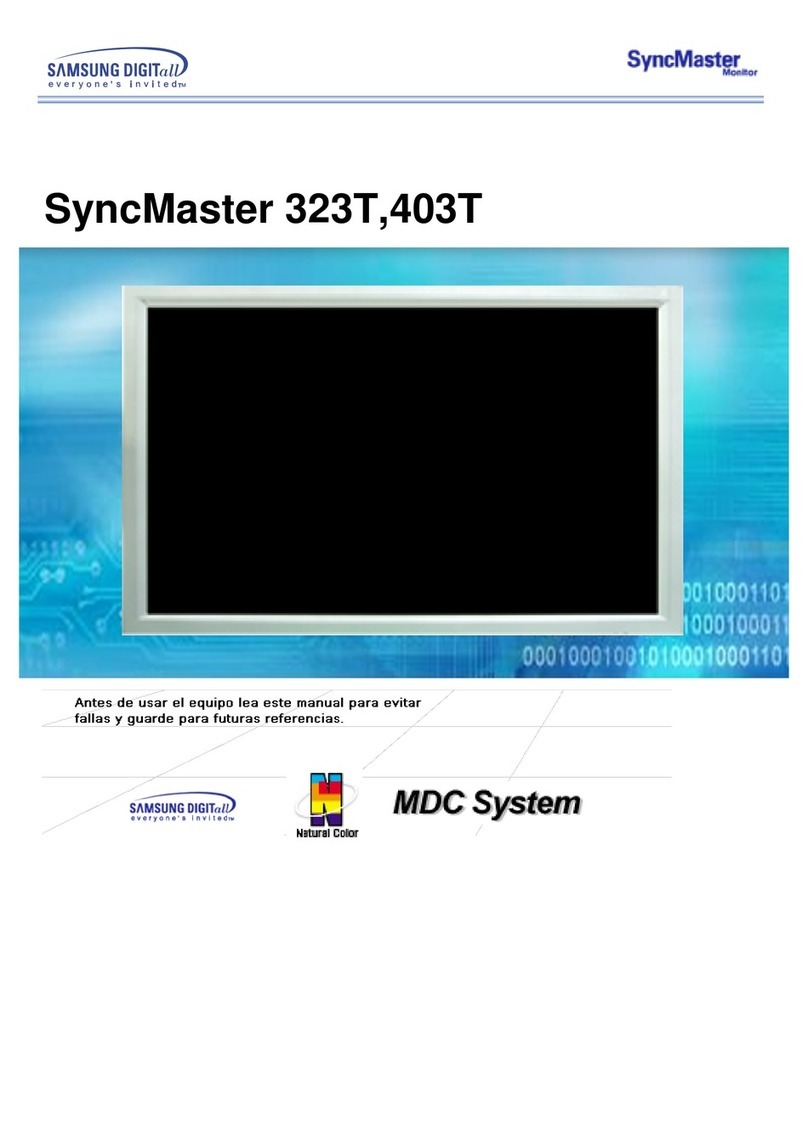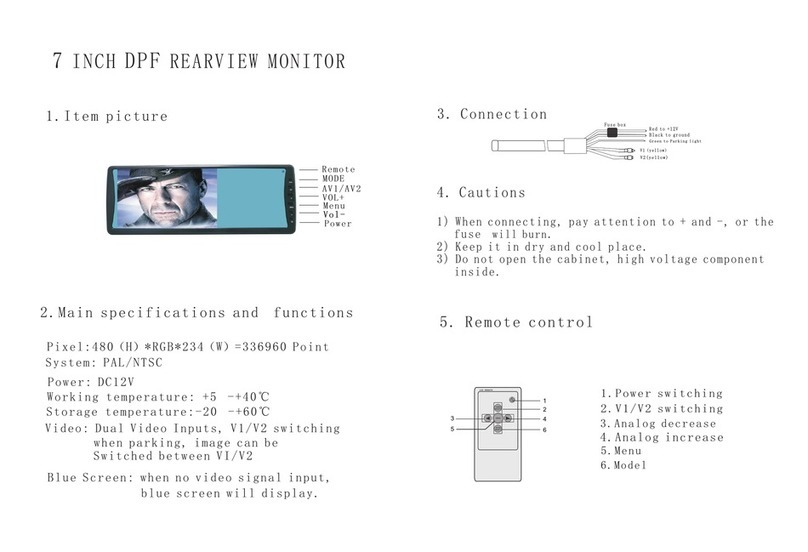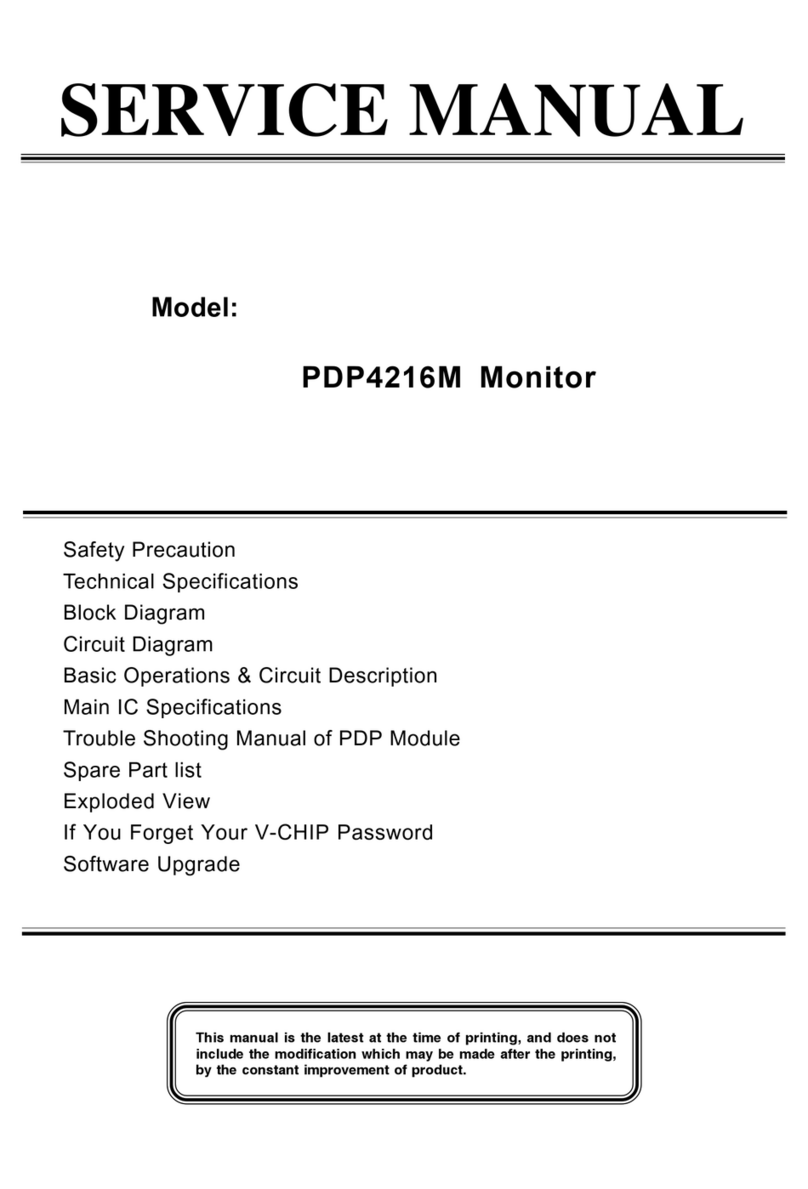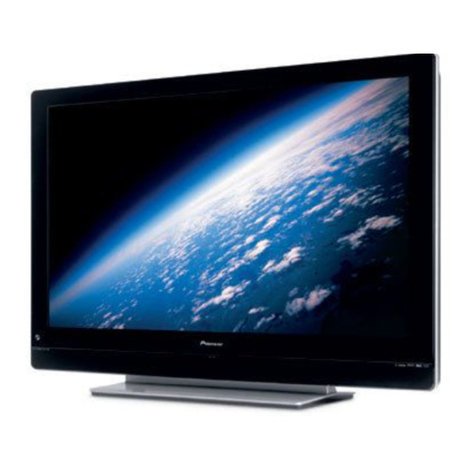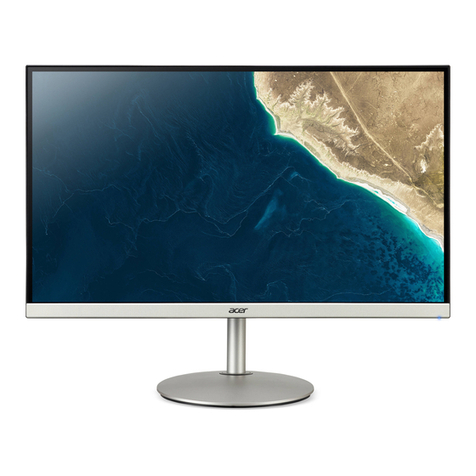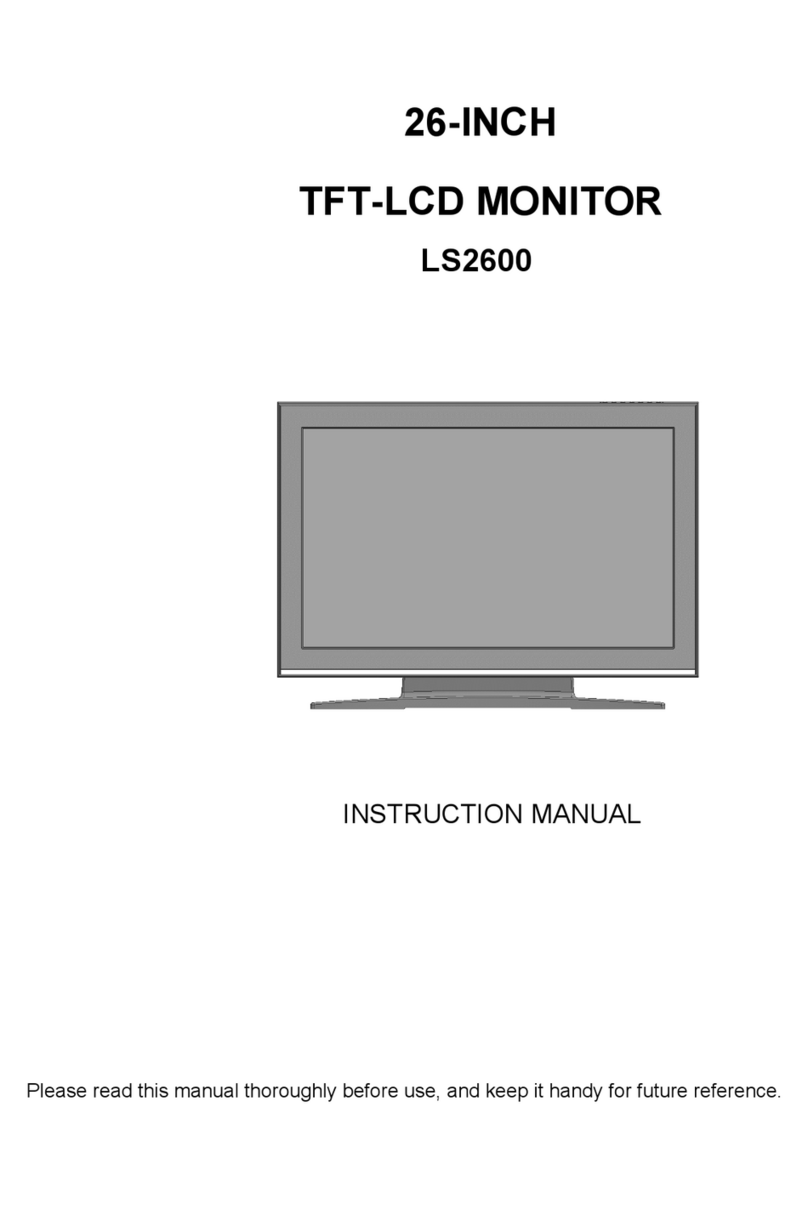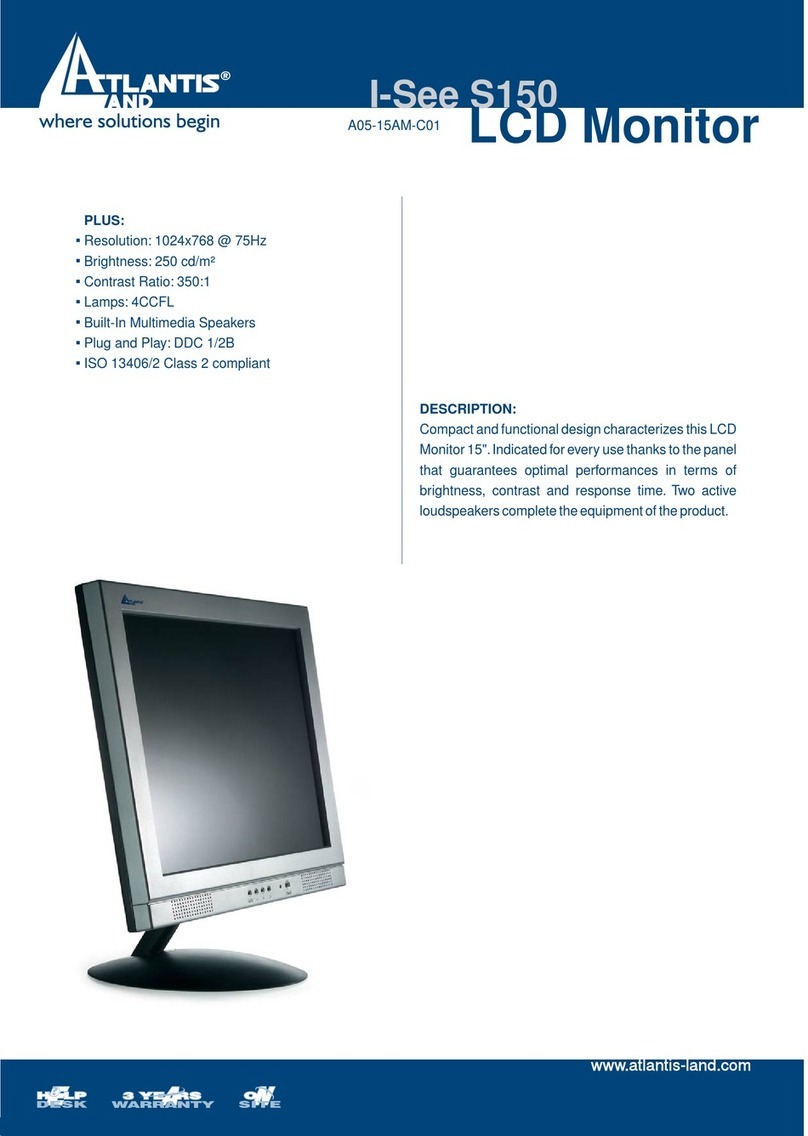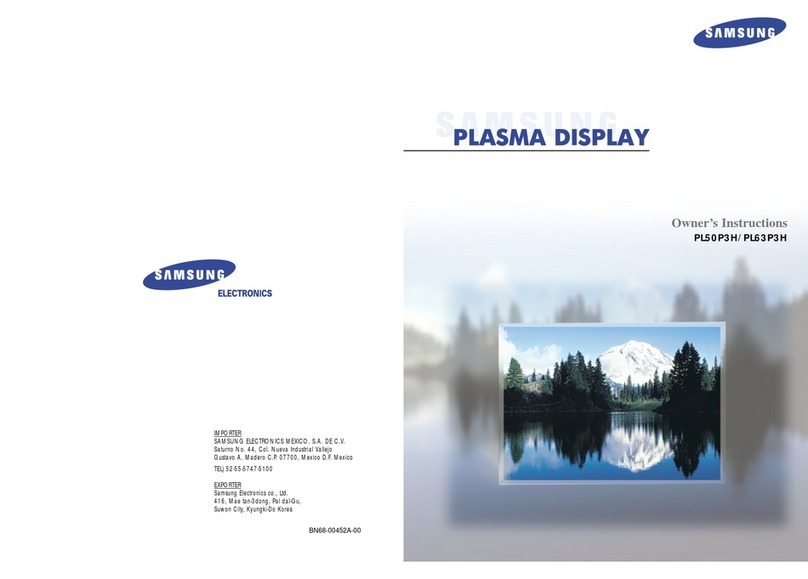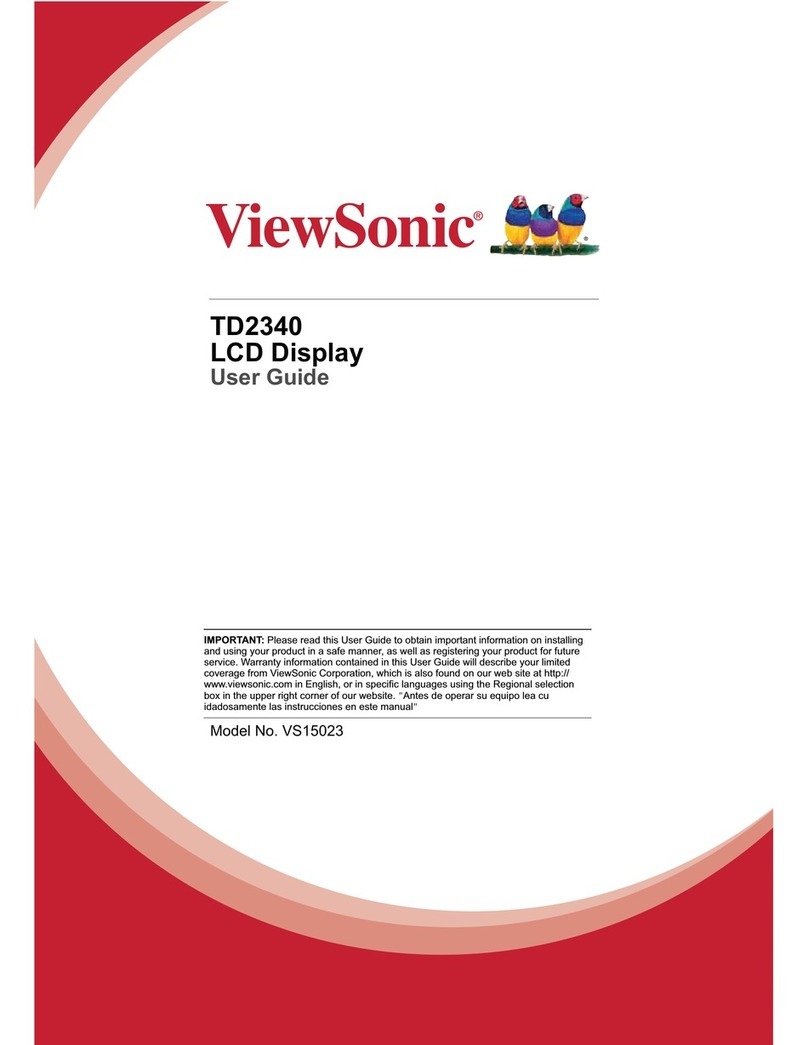aci Q6 Series User manual

Q6
Dual-Sensor Gas Monitor
INSTALLATION
OPERATION AND MAINTENANCE
MANUAL
AUTOMATION COMPONENTS, INC.
2305 PLEASANT VIEW ROAD | MIDDLETON, WI 53562
PHONE: (888) 96 -5224 FAX: (608) 831- 40
Web: workaci.com

Q6 Operation And Maintenance Manual
86650-001-000 RB Feb 22, 2019
1
READ BEFORE OPERATING 2
1
SPECIFICATIONS 2
1.1
ELECTRICAL/MECHANICAL SPECIFICATIONS ........................................................................................... 2
1.2
SENSOR SPECIFICATIONS ......................................................................................................................... 4
2
INSTALLATION 6
2.1
ENCLOSURES PHYSICAL DIMENSIONS ..................................................................................................... 6
2.2
LOCATION ............................................................................................................................................... 6
2.3
TERMINALS .............................................................................................................................................
2.3.1
Wire and Cable ............................................................................................................................. 8
2.3.2
Power Requirements ..................................................................................................................... 8
2.3.3
Q6 works alone ............................................................................................................................. 9
2.3.4
Q6 Connection wit Q-Controller .............................................................................................. 10
2.3.5
Q6 Connection wit M-Controller ............................................................................................. 10
2.3.6
RS-485 Terminator ..................................................................................................................... 11
2.3.7
RS-485 Driver Replacement ....................................................................................................... 11
2.3.8
Relays Output ............................................................................................................................. 11
3
FUNCTION AND CONFIGURATION 12
3.1
INDICATORS .......................................................................................................................................... 12
3.1.1
RS485-TX/RX ........................................................................................................................... 12
3.1.2
Relay 1-3 LED .......................................................................................................................... 12
3.2
TOOL FUNCTION ................................................................................................................................... 13
3.2.1
Enter Main Menu ........................................................................................................................ 13
3.2.2
Hus Buzzer and Relay ............................................................................................................... 13
3.2.3
Reset Latc ed/Hus ed ................................................................................................................ 13
3.2.4
Reset MENU Password .............................................................................................................. 13
3.2.5
Exit Tool Mode ........................................................................................................................... 13
3.3
MAIN MENU TREE ................................................................................................................................ 14
3.4
MENU “1_SYSTEM SETUP” .............................................................................................................. 15
3.4.1
System Settings ........................................................................................................................... 15
3.5
MENU “2_ZERO CAL” ........................................................................................................................ 18
3.5.1
Equipment Required ................................................................................................................... 18
3.5.2
Zeroing Calibration Procedure .................................................................................................. 18
3.6
MENU “3_SPAN CAL” ........................................................................................................................ 19
3.
MENU “4_OUT TEST” ........................................................................................................................ 20
3.8
MENU “5_VIEW SETTING” ............................................................................................................... 21
3.9
MENU “6_ALARM SETUP” ................................................................................................................ 22
3.10
MENU “ _RELAY STYLE” ............................................................................................................ 23
3.11
MENU “8_BUZZER STYLE” .......................................................................................................... 24
3.12
MENU “A_ALL DISABLE” ............................................................................................................ 24
3.13
MENU “B_SIMULATION” ............................................................................................................. 24
3.14
MENU “C_SITE SERVICE” AND “D_FACTROY SET” ................................................................. 24
4
MODBUS PROTOCOL SUPPORTED BY Q6 24
5
MAINTENANCE 25
5.1
SMART SENSOR ASSEMBLY REPLACEMENT .......................................................................................... 25
5.1.1
Disassembling ............................................................................................................................ 25
5.1.2
Replacement Procedure.............................................................................................................. 25
Accessories ............................................................................................................................................... 26
6
TROUBLESHOOTING 27

Q6 Operation And Maintenance Manual
86650-001-000 RB Feb 22, 2019
2
READ BEFORE OPERATING
All individuals who have or will have the responsibility of using, maintaining, or servicing this
product must carefully read this manual. The product will perform as designed only if it is
used, maintained, and serviced in accordance with the manufacturer’s instructions.
The Q6 is a state-of-the-art dual-sensor gas monitor that can operate as an independent, stand-
alone system or as part of an integrated system. The Q6 connects with digital interface to ACI
Q-Controller or M-Controller, or any PLC/DCS through Modbus RTU protocol. Setup
procedures are simplified with user friendly touchable buttons and LCD menus.
• Q6M: Q6 Main unit with smart sensor, relay, display and keypad
• Q6R: Q6 Remote unit with smart sensor only
1. Specifications
1.1 Electrical/Mechanical Specifications
Input Power: 24VDC nominal, range 18 to 30VDC, 0.3A DC Total Max.
24VAC nominal, range 15 to 24VAC, 0.3A AC Total Max.
(AC must not be grounded if connects to M-Controller)
Fuse: F2 on Main Board: Polyswitch 50mA
Polyswitch device resets after the fault is cleared and power to
the circuit is removed.
Sensor: Combustible gases: Catalytic or NDIR
Toxic gases and Oxygen: Electrochemical
Carbon Dioxide: Non-Dispersive Infra-Red (NDIR)
Sampling: Diffusion or Pump-through
Panel Indicators: 5 Status LED’s
• RS-485 TX Status (Green)
• RS-485 RX Status (Green)
• Relay1 Status (Red)
• Relay2 Status (Red)
• Relay2 Status (Red)
Display: LCD graphic display c/w backlight
Keypad: 3 capacitive touch sensing Keys: F1, F2, F3
Relays: 3 Relays SPDT, Dry contacts
• 1.0A maximum at 30 VDC (resistive load)
• 0.3A maximum at 125VAC (resistive load)

Q6 Operation And Maintenance Manual
86650-001-000 RB Feb 22, 2019
3
Buzzer: 55 dB at 10 feet, 2 00 Hz
Buzzer 1, 2, 3: Programmable tone
Tone: chirp once / chirp twice / 50% duty cycle / constant ON
Output Signal: RS-485 with ACI Controller Protocol
• Available Controller: M-Controller, Q4 Controller and
Q-Controller
RS-485 with Modbus RTU protocol
Enclosure Rating: IP 66 & NEMA 4, 4X, 12 & 13
Operating Temperature: -40°C to 50°C, depends on sensor specification
Ambient Humidity: 5% to 95% RH (non-condensing)
Storage Temperature: 0°C to 25°C, depends on sensor specification
Size: 150mm X 90mm X 65mm
Weight: Less than 0.5lbs

Q6 Operation And Maintenance Manual
86650-001-000 RB Feb 22, 2019
4
1.2 Sensor Specifications
Code
Gas Symbol
Gas
Density Span Operating
Temperature
16 Methane H4
Lighter
0 - 100%LEL -10° to +50°
17 Propane 3H8
Heavier
0 - 100%LEL -10° to +50°
18 Hydrogen H2
Lighter
0 - 100%LEL -10° to +50°
*19
ombustible LEL
0 - 100%LEL -10° to +50°
*20
Ethylene 2H4
Slightly
Lighter
0 - 100%LEL -10° to +50°
*21
Iso-Butane 4H10
Heavier
0 - 100%LEL -10° to +50°
*22
Iso-Pentane 5H12
Lighter
0 - 100%LEL -10° to +50°
*23
Methanol H3OH
Lighter
0 - 100%LEL -10° to +50°
*24
Benzene 6H6
Lighter
0 - 100%LEL -10° to +50°
*25
Acetone H3 O
Lighter
0 - 100%LEL -10° to +50°
*26
Butanol, n-Butane
BUTAN
Heavier
0 - 100%LEL -10° to +50°
Code
Gas Symbol
Gas
Density Span Operating
Temperature
0 Oxygen O2 0 - 25%VOL -30° to +55°
Code
Gas Symbol
Gas
Density Span Operating
Temperature
1 arbon Monoxide O
Slightly
Lighter
0 – 250ppm -20° to +50°
1 arbon Monoxide O
Slightly
Lighter
0 – 1000ppm -20° to +50°
2 Hydrogen Sulfide H2S
Heavier
0 – 25ppm -20° to +50°
2 Hydrogen Sulfide H2S
Heavier
0 – 100ppm -20° to +50°
3 Sulphur Dioxide SO2
Heavier
0 – 6ppm -20° to +50°
5 Nitrogen Dioxide NO2
Heavier
0 – 10ppm -20° to +50°
6 Hydrogen H2
Lighter
0 – 1000ppm -20° to +50°
6 Hydrogen H2
Lighter
0 – 2000ppm -20° to +50°
7 Hydrogen yanide
H N
Lighter
0 – 50ppm -20° to +50°
9 Ammonia NH3
Lighter
0 – 100ppm -30° to +50°
9 Ammonia NH3
Lighter
0 – 1000ppm -30° to +50°
11 Ozone O3
Heavier
0 – 1ppm -20° to +40°
13 hlorine l2
Heavier
0 – 5ppm -20° to +50°
14 hlorine Dioxide lO2
Heavier
0 – 2ppm -20° to +40°
96 Arsine AsH3
Heavier
0 – 1ppm -20° to +40°
97 Phosphine PH3
Heavier
0 – 5ppm -20° to +40°

Q6 Operation And Maintenance Manual
86650-001-000 RB Feb 22, 2019
5
97 Phosphine PH3
Heavier
0 – 1ppm -20° to +40°
98 Silane SiH4
Heavier
0 – 50ppm -20° to +40°
99 Germane GeH4
Heavier
0 – 2ppm -20° to +40°
100
Diborane B2H6
Slightly
Lighter
0 – 2ppm -20° to +40°
4 Nitric Oxide NO
Slighter
Heavier
0 –100ppm -20° to +50°
8 Hydrogen hloride
H l
Heavier
0 – 30ppm -20° to +40°
12 Ethylene Oxide ETO
Heavier
0 – 20ppm -20° to +50°
101
Hydrogen Bromide
HBr
Heavier
0 – 30ppm -20° to +40°
Code
Gas Symbol
Gas
Density Span Operating
Temperature
15 arbon Dioxide IR- O2
Heavier
0 – 5000ppm -20° to +50°
15 arbon Dioxide IR- O2
Heavier
0 – 5%VOL -20° to +50°
15 arbon Dioxide IR- O2
Heavier 0 – 20%VOL -20° to +50°
15 arbon Dioxide IR- O2
Heavier
0 – 100%VOL -20° to +50°
16 Methane IR- H4
Lighter
0 – 100%LEL -20° to +50°
16 Methane IR- H4
Lighter
0 – 100%VOL -20° to +50°
*NOTE: Mounting Heights - Low = 9-18 inches (0.25-0.5 meters) from floor
- Mid = 4-6 feet (1.25-1. 5 meters) from floor
- High = 9-18 inches (0.25-0.5 meters) from ceiling

Q6 Operation And Maintenance Manual
86650-001-000 RB Feb 22, 2019
6
2. Installation
2.1 Enclosures Physical Dimensions
The enclosure is a NEMA 4 rated enclosure and can be wall mounted with 4 screws. To
maintain the NEMA rating, it is important that the conduit opening is sealed upon installation.
2.2 Location
The transmitter should be mounted where the gas to be measured is most likely to be present.
This location will be dependent on the source of the target gas and whether that gas is lighter
or heavier than air. Air circulation and mixture should also be taken into account.
CO gas is lighter than regular air, it can be mounted on the walls at least a couple of feet below
the height of the ceiling. As the monitor Q6M has a digital read-out, placing it at about eye
level is strong recommended. The Q6R is the remote unit, so it can be placed at any location
according the target gas source.
The location should be accessible for the purposes of routine re-calibration and periodic sensor
replacement. Sufficient room should be left to allow the enclosure cover to be removed and the
connection of the calibration adapter to the sensor chamber. For sensor element replacement
there will need to be enough room to remove enclosure cover and the sensor board assembly.
NOTE: The monitor can also be installed in limited outdoor environment - An ambient
air environment that is not climate controlled and is not in direct contact with the
elements of nature, such as wind, rain, sleet or snow Examples of limited outdoor
environments include parking garages, construction complexes, sports venues, boats and
recreational vehicles
NOTE: Avoid mounting the monitor near 600 VAC switchgear and other sources of
radio frequency and/or electromagnetic interference While RFI/EMI protection is built
in to the monitor, excessive levels of interference may cause instability in the output
signal

Q6 Operation And Maintenance Manual
86650-001-000 RB Feb 22, 2019
2.3 Terminals
Q6M Terminals
Q6R Terminals

Q6 Operation And Maintenance Manual
86650-001-000 RB Feb 22, 2019
8
2 3 1 Wire and Cable
Terminal blocks TB1 to TB accept 12 AWG to 24 AWG wire. Use 16 AWG or 18 AWG
wire for the power supply in long wiring runs, which can be up to 1km (1,000 meters) long.
We recommend using BELDEN 9841 for communications. This wire has 120 ohm input
impendence, which will eliminate RS-485 communication problems.
2 3 2 Power Requirements
The Q6M and Q6R power supply voltage requirements are nominally 24VAC or 24VDC.
The Q6M and Q6R both have full wave rectifier and half wave rectifier on board. If the Q6
works alone, the 24VAC/DC can connect to either full wave rectifier or half wave rectifier
connectors. If the Q6 connects to controllers, you will damage devices if you mix half wave
and full wave rectifiers on the same AC source. Use extreme caution when sharing a common
AC source. Sharing a common DC source is less problematic.
• ACI Q-Controller uses half-wave rectifier only, M-Controller uses full-wave rectifier
only, so the Q6 can work with both controllers
• When the Q6 shares a common AC source with a Q-Controller, use the half wave
rectifier connector Q6M TB5 and Q6R TB2
• When the Q6 shares a common AC source with an M-Controller or Q4 Controller, use
the full wave rectifier connector Q6M TB4 and Q6R TB1

Q6 Operation And Maintenance Manual
86650-001-000 RB Feb 22, 2019
9
2 3 3 Q6 works alone

Q6 Operation And Maintenance Manual
86650-001-000 RB Feb 22, 2019
10
2 3 4 Q6 Connection with Q-Controller
2 3 5 Q6 Connection with M-Controller

Q6 Operation And Maintenance Manual
86650-001-000 RB Feb 22, 2019
11
2 3 6 RS-485 Terminator
Factory default setting is disabled terminator.
The Q6M supplies this resistor on the main board, and it is chosen using a jumper at J4.
• J4 1-2: Terminator Disabled / OFF (default)
• J4 2-3: Terminator Enabled / ON
2 3 7 RS-485 Driver Replacement
RS-485 lines in heavy industrial environments are sometimes subjected to magnetic
disturbances causing sufficient inducted power surges to damage the driver integrated circuit
(IC). This IC (U6) has a socket on the circuit card for ease of replacement in the field.
2 3 8 Relays Output
The Q6M has three onboard programmable Single-Pole Double-Throw (SPDT) relays. These
relays can be used to control other equipment, such as fans, lights, horns, etc. eliminating the
need for a separate controller.
Three terminal blocks (TB1, TB2 and TB3) are located on the main board. Each relay can be
programmed individually.
Switching capability of each relay is:
• 1.0 A maximum resistive load at 30 VDC
• 0.3A maximum resistive load at 125VAC

Q6 Operation And Maintenance Manual
86650-001-000 RB Feb 22, 2019
12
3. Function and onfiguration
3.1 Indicators
The indicators consist of five LED’s – two to indicate RS-485 digital communication, three to
indicate the status of relays 1-3.
3.1.1 S485-TX/ X
When the Q6M is connected to a controller system via RS-485, the traffic of the
communication can be monitored visually through the two RS-485 indicators. One is RX
LED, which indicates the data stream received in from the controller. The other is TX LED,
which indicates the data stream out of the Q6M.
Note: If the TX LED or the RX LED is always ON, is indicative of a communication
problem See Troubleshooting for RS-485
3.1.2 elay 1-3 LED
Indicate the status of each relay. When the relay is actuated/closed, the relay LED is ON.
When the relay is de-actuated/open, the relay LED is OFF.
Note: If you set the relay to be Normally Energized (Fail Safe), the relay LED will turn
ON at non-alarm state and turn OFF at alarm state, because the LED reflects the relay
coil status

Q6 Operation And Maintenance Manual
86650-001-000 RB Feb 22, 2019
13
3.2 Tool Function
Press key [F3] to enter tool functions that might be used frequently in the field.
TOOL FUNCTION
F2
F2
F2
F2
2. HUSH
BUZZER/RELAY
PRE NEXT ENTER
3. RESET
LATCHED/HUSHED
PRE NEXT ENTER
1. ENTER
MAIN MENU
PRE NEXT ENTER
4. RESET
MENU PSW
PRE NEXT ENTER
F1
F1
F1
F1
F2
5. TOOL MODE
EXIT?
PRE NEXT ENTER
F1
RESET
LATCHED / HUSHED
PRE NEXT TOOL
F1 KEY F2 KEY F3 KEY
3 2 1 Enter Main Menu
Press key [F1] to browse previous item of the current menu.
Press key [F2] to browse next item of the current menu.
Press key [F3] to enter the main menu for more configuration and settings.
3 2 2 Hush Buzzer and Relay
Press key [F3] to silence the buzzer and buzzer-style relays.
3 2 3 Reset Latched/Hushed
To acknowledge a latched condition or a hushed condition, press key [F3] to reset latched
relays and hushed buzzer for which the alarm condition has been removed. If the alarm
condition (e.g. high gas concentration) is still present the relay(s) will not reset.
3 2 4 Reset MENU Password
If you forgot the main menu password, you can reset the menu password to default password
“4321” by entering a correct active code. For the active code, contact ACI.
3 2 5 Exit Tool Mode
Press key [F3] to return to monitoring mode.

Q6 Operation And Maintenance Manual
86650-001-000 RB Feb 22, 2019
14
3.3 Main Menu Tree
The main menu is password protected. Once the password is accepted, you are allowed into
the main menu tree.
Factory default password is 4321
Note: While in the menu tree, all normal monitoring operations stop The alarm status
does not change

Q6 Operation And Maintenance Manual
86650-001-000 RB Feb 22, 2019
15
3.4 Menu “1_SYSTEM SETUP”
The system setup subdivision contains general settings for monitor operations,
communications.
3 4 1 System Settings
Password: Default password is 4321.
Q6M
MAC
Address:
Q6M monitor address can be defined from 0 to 255. Default is 3.
Q6R address would be address + 1
Note: In Modbus protocol, the address 0 is for broadcast.
Baud rate: Define baud rate for RS-485 communication with ACI controllers OptoMux
protocol or other SCDA system with Modbus protocol.
Q6 default baud rate is 4800 bps
Scroll Rate: In normal operation, the sensor and relay status information scrolls
automatically. Set the number of seconds for each item to be displayed.
Default value is 3 seconds.
Backlight: The LCD backlight can be set to Always Off, Always On and Auto Power
Saving mode. In Auto Power Saving mode, the backlight will turn on for 10
seconds after any key has been pressed. Default setting is Auto.
New
Password:
The new password can be any combination of up to four digits. Default
password is 4321.
Warning: Be sure that you record the new password in a safe and
secure location!
Protocol: The Q6 Default protocol is OptoMux.
The Q6 also supports Modbus protocol, responds as a Modbus Slave using
RTU protocol. When it’s set to Modbus, the parity bit can be defined as
EVEN, ODD and No Parity.

Q6 Operation And Maintenance Manual
86650-001-000 RB Feb 22, 2019
16
Display
Mode:
• Display Instant: displays instantaneous gas concentration
• Display Average:
o Displays STEL (15min average reading)
o Displays TWA (8 hour average reading)
o Displays daily peak
• Display Alarm: displays alarm 1-8 status
• Display Relay: displays relay 1-3 status
• Display Buzzer: displays buzzer 1-3 status
• Display A-Out mA: Not Available for Q6
• Display A-Out VDC: Not Available for Q6
• Display Clock: displays real time clock (Default is no clock display)
If there is nothing to display, the unit will display “Running…”
Auto Zero: Settings for both Q6M sensor and Q6R sensor
When AutoZero is set to ON, the unit will gather the lowest reading in -day
period and set the unit into Zeroing Calibration mode so that the lowest
reading goes to zero. When AutoZero is set to OFF, the unit will not adjust
its own zero and work off the last manual or factory calibration.
Default value is OFF.
NOTE: AutoZero works best in situations where the building will
purge at night (or over a weekend) to a zero concentration of target gas
Key
Beeper:
ON: Beeping when keypad is touched
OFF: No beeping when keypad is touched
Restore
Default:
Note: Don’t do this if you don’t have calibration gas and precision
reference instrumentation to calibrate the unit
To load defaults to factory settings, to restore the unit to correct operation.
The settings below will be restored to default values:
-Password, -Scroll rate, -Backlight, -Display mode, -Key beeper, -LCD
contrast, -Gas type on the Sensor Board, -Alarm settings, -Relay/Buzzer
settings.
Zero and span calibrations are needed.

Q6 Operation And Maintenance Manual
86650-001-000 RB Feb 22, 2019
1
ADJ Clock: Adjust real time clock.
ADJ
Contrast:
Adjust the LCD contrast. Valid values are between 10 (light) and 50 (dark).
Default is 21.
Q6 Sensors:
If the smart sensor in Q6M unit is not installed, it can be disabled here, so
the Q6M will not detect the smart sensor board and will not report any fault
on the sensor offline
If the smart sensor in Q6R is not installed, it can be disabled too.
Both default values are ON, that means both Q6M and Q6R sensors are
installed.

Q6 Operation And Maintenance Manual
86650-001-000 RB Feb 22, 2019
18
3.5 Menu “2_ZE O CAL”
First to select which sensor is going to be calibrated, Q6M or Q6R? The subsequent zero
calibration will be performed on that sensor.
The calibration is using a two-point calibration process. First, use a “Zero Gas”, then use a
“CAL Gas” containing a known concentration of a standard reference gas, to set the second
point of reference.
3 5 1 Equipment Required
• A cylinder of Zero Gas, (clean air or nitrogen).
• A cylinder of Cal Gas
• Flow Limiting Regulator(s) 0 2 to 1 0 lpm
• Tubing
3 5 2 Zeroing Calibration Procedure
• “2_ ZERO CAL:”
• Press key [F3] and the device will show the calibration notice and then ask if you want
to continue. The middle line will display the current concentration.
• Apply the Zero Gas.
• Wait for about 3 minutes or until the reading is stable.
• Press key [F3] to confirm Zeroing Cal.
• When the device is in Zeroing CAL, it will take 3 seconds to 20 seconds to complete.
• When the zeroing CAL operation is over, the device will display “Accepted” and
return to “2_ZERO CAL”.
• Make sure there is no Cal Error displayed. If Cal Error is reported, repeat the
procedures above. If the Cal Error is still showed up, the sensor may be expired.
• Remove the gas.
• Exit the menu to Monitoring Mode.
2_ ZERO CAL
CONTINUE?
XXPPM

Q6 Operation And Maintenance Manual
86650-001-000 RB Feb 22, 2019
19
3.6 Menu “3_SPAN CAL”
First to select which sensor is going to be calibrated, Q6M or Q6R? The subsequent span
calibration will be performed on that sensor.
• “3_ SPAN CAL”
• Press key [F3] and the device will ask for the CAL GAS, input the concentration of the
calibration gas.
• Press key [F3] and the device will show the calibration notice and then show the flow
rate for the span calibration. Press any key to continue, and then the device will ask you
if you want to continue. The middle line will display the current concentration.
• Apply the calibration gas.
• Wait for about 3 minutes or until the reading is stable.
• Press key [F3] to confirm SPAN CAL.
• When the device is in span cal, it will take 10 seconds to 1 minute to complete.
• When the span cal operation is over, the device will display “Accepted” and return to
“3_SPAN CAL”.
• Make sure there is no Cal Error displayed. If Cal Error is reported, repeat the
procedures above. If the Cal Error is still showed up, the sensor maybe expired.
• Remove the gas.
• Exit menu to Monitoring Mode.
3_ SPAN CAL
CAL GAS:
>
XXX
CONTINUE?
XXPPM
This manual suits for next models
2
Table of contents
Other aci Monitor manuals
